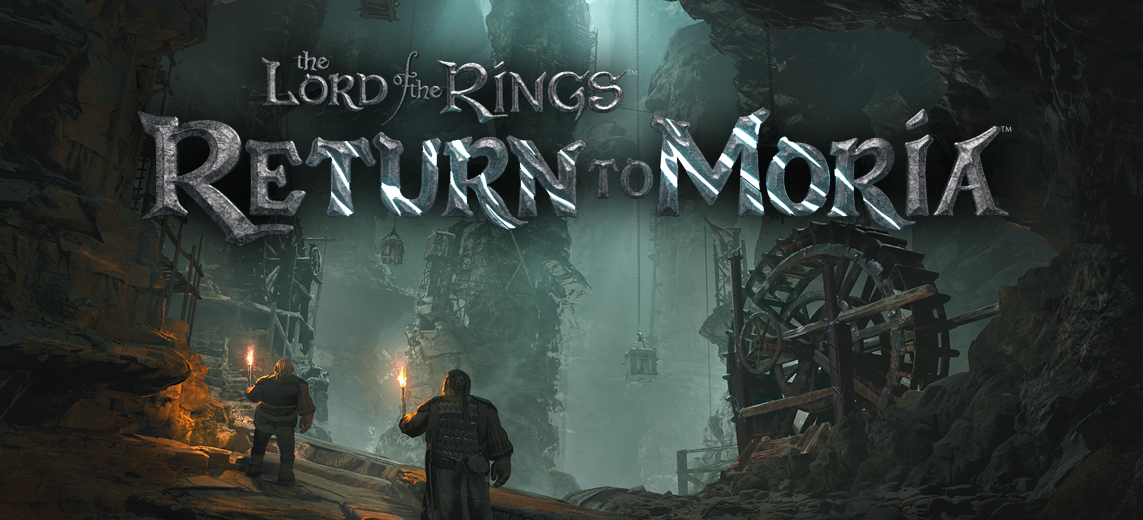Lord of the Rings: Return to Moria is a unique and impressive survival game that takes place in Tolkien’s universe with a focus of reclaiming the Mines of Moria as a Dwarf. It’s more story-based than other survival games (such as Valheim), while also being unique enough to define itself as something other than a clone or copy of other titles.
I played the game all the way through to the end, built bases, upgraded to the best gear, and explored every nook and cranny I could find. The whole experience took quite some time, and when I saw this game getting review bombed within 48 hours of launch by critics complaining about… pretty much everything… I can say with reasonable certainty they really didn’t play the entire game. Because it would have taken them much longer to experience everything the game has to offer. Not only does it have a lot to offer, the game gets better the longer you play it.
I want to acknowledge how difficult it is to make any type of game, especially in today’s saturated and tough market of unprecedented consumerism. The team that created this game should be proud of what they built. A lot of developer love went into Return to Moria, and it shows.
People who are drawn to these types of games, and especially the LoTR lore, want to live in Moria. And with this game, they can. Return to Moria is definitely worth playing and I can’t wait to see how the developers at Free Range Games evolve this quality product.
- Developed By: Free Range Games
- Release Date: October 24, 2023
- Version Reviewed: 1.0.2.113940
The design, lore and ambience of Tolkien’s Moria is perfect for an adventure-based survival game. From what I can tell, this was Free Range Games first really big project. The company has more than 100 employees and is based in the Bay Area. I don’t know how long Return to Moria was in development, but they put together a solid game with very few bugs and immersive world.
So how is the game? Did the developers deliver? Is Return to Moria a game worth purchasing and playing? Let’s find out!
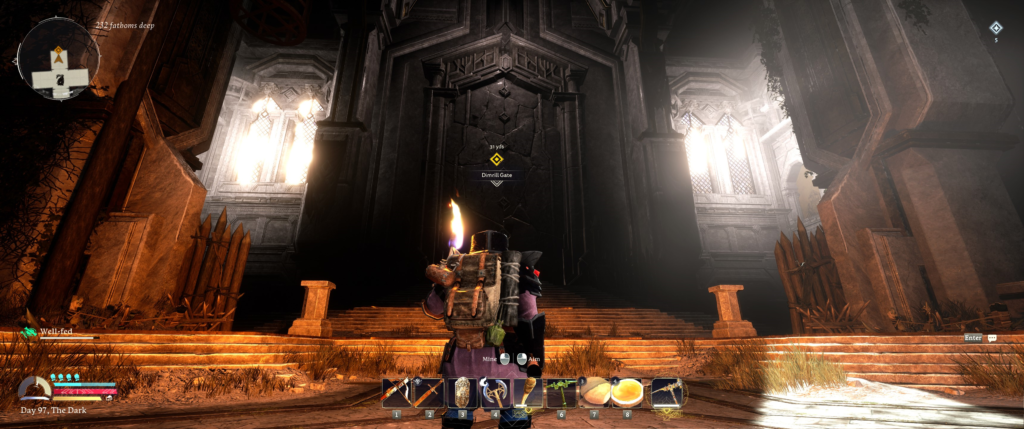
Table of Contents
Content
The environmental content and lore of this game are the most impressive factors. Return to Moria has top notch voice acting, music, majestic underground regions and ambience. The player truly feels like they’re a Dwarf in Moria. The game is very immersive, but also dangerous. The first playthrough can be very rough, especially for those who are playing solo. I’ll admit to frustrations that almost caused me to quit the game, however I am very glad I continued to play, because the games just gets better the more you play, and that says a lot. For anyone frustrated with this game, just remember one simple mantra: Just keep digging!
Each world created in Return to Moria is a procedurally generated grid-based system of pre-created regions that are snapped together between sections. The game does not feature true procedural generation like Valheim, but for the way it was designed, the system works well. Additional playthroughs all have the same core locations but different ways of getting to them. This includes different layouts of ore deposits as well. My first playthrough had one tin deposit… in the whole game. It was just bad RNG. In the end, the gaming experience revolves around proceeding deeper into the mines and securing forges to make new equipment and crafting stations. These include items for structures, lighting, food, drink, sleep, repair, transportation, and even planting for vegetables.
Character Creation is well-done and fun. The player can customize their Beard, Head, Hair, Skin, Eyes, Tattoos, Scars, and Body dimensions (Shoulders, Chest, Bust, Belly, Waist). There’s even different choices for Personality Voice and region of Origin, although I’m not sure what the last option changes. Players can create bearded Dwarven women with husky voices or stout male Dwarves with silly voices. The process is quite enjoyable and the selected voice carries through the entire game.
One cool thing about the character system is the player can customize their character at any time. So if one is halfway through the story and wants a different voice, core look or disposition, just update the character!

The World is huge and includes gigantic underground regions that are outright magnificent. The first time I stepped into the actual mines of Moria and looked upward was quite the treat. There are so many unique and beautiful places, including the Elven Quarter and Durin’s Tomb. The design is fantastic, and the player is led through the world of Moria by the storyline. And the story is very good. The core goal of the game is to regain control of and rebuild Moria. Players are given the option to do exactly that. Building is allowed anywhere, and to my knowledge doesn’t have a limit. On the other hand, destroying objects is also part of the game (in order to obtain materials). In the end, a player can truly rebuild Moria, which also includes cleaning out the orc and other crap that’s clogged the mines.
The game does a good job of directing the player from one goal point to another while also allowing for extensive exploration. There are currently five regions in the game, which are: Barazinbar, The Western Hills, The Lower Deeps, and Dwarrowdelf. Each zone represents a different tier of gear, buildable stations, equipment, construction pieces, and monsters. The last zone is also the first: Barazinbar, but a different part of it.

Barazinbar is the starter area, but also the ending area. It’s very basic and introduces the player to the core concepts of the game. The Western Hills has both the Elven Quarter and Mines of Moria. The Elven Quarter has the Forge of Narvi, which allows for the first crafting of a Tier II weapon. The Lower Deeps has luminescent mushrooms and water. It has the Belegrost Forge, which allows for Tier II armor and a Tier III weapon. Around this time, the player unlocks the Khuzdul Forge, which allows for creating Tier IV weapons and Tier III armor. Dwarrowdelf is an underground city. It has both the Nogrod Forge and Durin’s Forge. Nogrod allows for the crafting of Tier V weapons, and Durin’s Forge allows for crafting Tier V armor. Returning to the new section of Barazinbar has the Mithril Forge, which allows the crafting of Tier VI weapons and armor. Reactivating the forges is a very cool event and visually rewarding.
Players unlock crafting Recipes through a number of methods, which mainly include repairing statutes, gathering figurines, and putting together ranger log books. Building certain forges and other crafting stations also unlock different items. And there’s a lot to build in this game.
One complaint many players have is the difficulty in finding all of the figurines or ranger scrolls for a specific region. I can confirm this is a point of frustration. I think the developers are going to have to address this in some way, perhaps allowing for the crafting of the missing items if the player has already moved to the next tier.
You’re a dwarf. Mining is what you do. Characters can mine ore and gems from veins and rocks, which includes Iron, Bronze, Silver, Mithril, Sapphires, Emeralds, Rubies, and even crystals like Sun-stones. One of the most sought after materials are Black Diamonds, which are used to build Map Stones (fast travel waypoints). Some resources are Renewable and others are not. You’ll also be cutting down trees and giant mushrooms to gather wood and other materials. There’s also herbs, plants and vegetables scattered throughout the world that are required for crafting food, ale, and other consumables. Plants will regrow and many scattered items like scrap metal will also respawn. There are also mineable stones that respawn throughout the game, which ensures the player can always find ore even if they’ve mined all of the main veins. Things that do not respawn include ore veins (mined from the walls), breakable objects in structures, and elven trees. In other words, the world is packed full of resources and there’s always something to mine or smash in order to get more materials.
One of the most unique features of this game is the Singing, and it’s fantastic. Signing while mining, drinking ale, and rebuilding statues. It’s truly a very unique and well-implemented feature of the game. It’s also very common to hear the Orcs Talking to each other as they patrol the area or protect a base. It’s quite enjoyable to hear them talk about the Balrog and other lore-related events that took place in the past. It’s also a nice way to warn the player an Orc patrol is nearby. And for those of you who are really into the lore, here are numerous Signs of the Fellowship to be discovered, which is nostalgic of the books and movies.
Weapons and Armor range from Tier I to VI. Most weapons are melee, but the game also has bows and crossbows. The different armor tiers also look more impressive the stronger they are. Both weapons, shields and armor must be Repaired regularly, which cost Metal Scraps. Armor works like a shell. It absorbs damage until it’s broken. Shields are the same way.
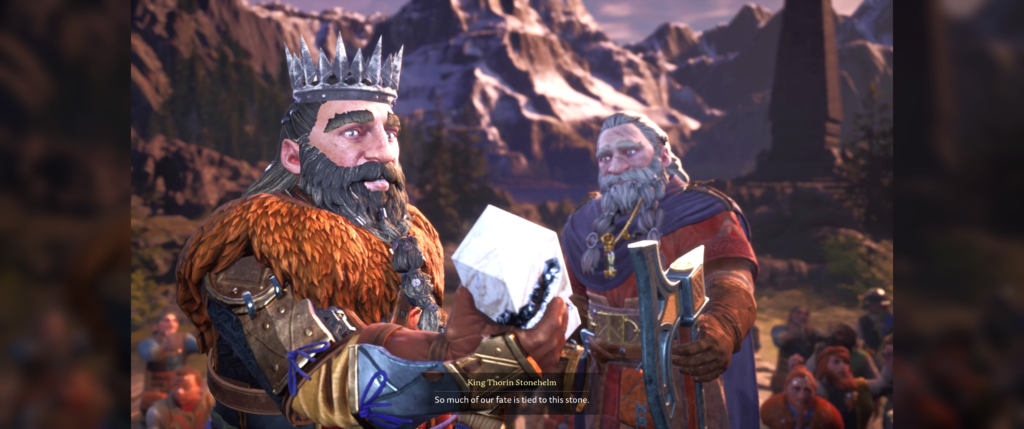
There are three Packs in the game: Scout (10 slots), Adventurers (25 slots) and Mountaineer (40 slots). Packs define how much storage the character has. There is no weight metric in the game, so it’s all about open slots.
Players can also Enchant their weapons. While the game has 11 slots at the Rune Table, 3 are currently missing from the game so the player can discover and apply 8 enchantments to their weapons. These enchantments include Fire, Cold, Orc damage and extra damage to Dragons. There’s even an enchantment you can put on your axe to cause normal trees to drop Ironwood. Enchantments are unlocked through Gems. I found the Orc Damage enchantment to be the most useful, and love how the weapon glows and hums when Orcs are around.
One of the features that’s visually very cool in addition to the general building pieces available is that of item Pallets and Gold Piles. Players can gather and stack tons of crafting materials (ore, wood, ingots, etc.) for use as they adventure throughout the realm of Moria.
The player must be very careful as they explore. Make too much Noise and a horde of orcs might attack. And when I say horde, I mean a horde. New players are often utterly destroyed by the first few hordes as they are still learning about combat. Player bases can also be raided, which is covered in more detail below. Shadow Curse is a deadly purple haze that has spread throughout Moria and poisons the character if they step in it. It’s also a key part of the main story. Players must also battle despair from being in the Darkness for too long. There is also the chance of being poisoned through mushrooms or infected monsters. The realm of Moria is a rough place!
There are plenty of dangerous Creatures in the game, but the most common are different variations of Orcs, which have small camps scattered throughout Moria. And each region has a larger base which includes an orc boss. If the player clears out the major orc base and kills the leader, the hordes drawn by sound will stop for that region.
There are also bears, mountain goats and elven elk-like creatures the player can hunt for meat. Worgs also give meat, but are much more dangerous. The player must also kill multiple Orc Leaders, a Watcher in the water, a Troll King, Wyrms, Trolls, and the final end-game Dragon.
One interesting note is players can jump their character between worlds to farm resources to bring back to their game. This allows for majestic builds that normally wouldn’t be available due to a lack of resources.
Unfortunately, there are no NPCs. The developers could do a lot in the future with this; for example, after conquering Moria and finishing the storyline, groups of Dwarves could start settling parts of different regions. This could open up a use for Gold Coins beyond just piling them up. Merchants!
And finally, we have Dark Mine Shafts. These are the deepest and darkest parts of the game where the most valuable gems and ore can be found, but they can also harbor the strongest nasty monster in the game, called the Nameless. These shafts are worth building a mapstone in because the rocks respawn and give fantastic rewards, including Black DIamonds.
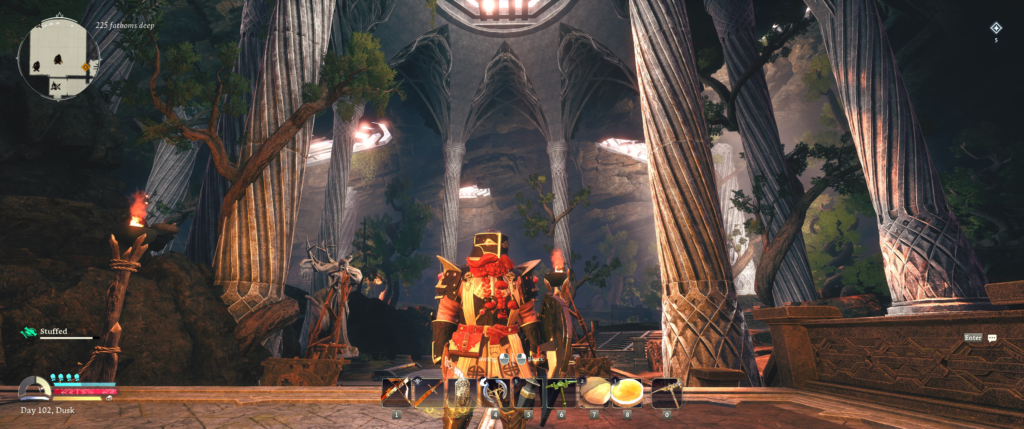
Gameplay & Mechanics
Return to Moria is all about Resource Gathering, which comes in the form of destroying objects and mining. The general rule of thumb is pick up everything you can because you’ll need it. Not just for base building, but crafting items, stations, food, ale, and more. Inventory management can be a challenge at the beginning of the game, but if players plan and set up mapstones appropriately, they can quickly and efficiently transport goods to their main base or sub-bases. Players can also Repair statues and other objects with their hammer, which includes rebuilding abandoned or damaged bases spread throughout the realm.
The Building system is done quite well. It can be a bit clunky to snap pieces together or build complex structures, but I think the initial release did a great job with its grid-based system. The player can also quick-build both platforms and roped platforms, which allow for the easy traversal of dangerous vertical regions throughout the mines. There are a number of categories for building. The first, and most important, is Essentials and Crafting. This includes things like lights, beds, fires, cooking stations, storage, farming, resource pallets and more. The other categories are for building things like walls, stairs, columns, and floors. Players can also do Field Crafting, which allows for building anywhere in the world. These items include torches, pickaxes, flares and even the starter pack.
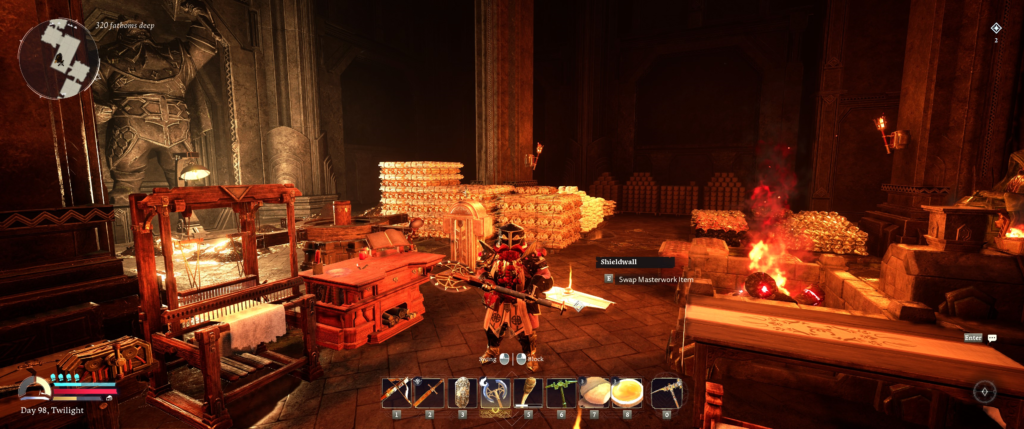
One key thing missing from the building process is moving a built object, like a crafting station or chest. At this time you have to destroy and rebuild it rather than just move it. I hope the developers add this feature as it’s very standard and a great quality of life improvement.
There is an in-game Appendices system that tracks everything from Ingredients to Foes. It’s a sort of compendium of discovery the player can read to learn more about the dark world of Moria. The Goals system guides the player through the storyline. The game has a comprehensive Recipe List system that lists everything that’s been discovered and how/where it can be built.
Many reviewers have panned the game for its Combat, but the reality is it works just fine for the current design of the game. The combat system allows reasonable survival without tweak-level reaction times. As such, the shield block option is critical to surviving any onslaught. There’s also knockdown attacks, charged attacks, and attack combinations that vary based on weapon. While I preferred using a one handed weapon and shield, using a strong 2H axe with a full charge was devastating when properly timed. Ultimately, the combat is very similar in nature to Valheim, but a bit more forgiving because of the sheer volume of monsters that can attack during a horde raid.
There is no pause feature for those who play the game solo, which is a major oversight by the developers. Valheim made the same mistake at launch and quickly addressed the issue. I hope the developers of Return to Moria do the same.
Characters have Health and Armor. Like any other game, when health reaches zero, the character dies. Armor helps absorb damage. There is also a listing of Character Stats, but it’s difficult to tell what all of them do or how they are adjusted. Things like Mining Luck or Poison Buildup Rate obviously have an impact, but how? They aren’t listed on items. Neither are damage resistances against things like Fire or Slashing. There’s also a Critical chance, but I’ve never seen the game score a critical hit. So it appears there’s a character stat system in place the developers plan on expanding in the future, which will be very interesting. The good news is the core game as it stands at its initial release is solid and fun to play, so things can only get better.

Movement throughout Moria is done by walking, running, jumping & climbing. Players can also easily build platforms and rope ladders, which are critical for avoiding the shadow curse and navigating the vertical cliffs throughout the realm. And finally we have Mapstones, which are the most important build pieces for exploration unlocking late early-game. These are waypoints that allow for instant travel and are both found to be repaired and can be built from scratch. Note it costs Black Diamonds to repair or build. While it may appear they are rare in the beginning, the player quickly finds themselves swimming in Black Diamonds late game.
Let’s talk about the Map system. First, it’s important to understand that Moria is a BIG game, and because of the procedural linking of sections, each world is different in layout, but always has the same parts. The big problem with this game and its map system is it’s nearly impossible to track the multi-layer nature of late-game regions. When the player starts the game, the map is fine, showing which sections connect to others and have been visited. But at end-game, it’s nearly impossible to identify missed areas. What makes things worse is the real-time map (in the upper left corner) doesn’t match the in-game main map. This makes things even more confusing. It’s my opinion a 3D map system would have been the correct choice for this game, and I hope they update the system in the future.
Players can rename their Map Stones through the map UI by clicking on the icon and selecting Edit.
Managing Buffs and Debuffs is a critical part of the came. The first is that of Light vs. bring immersed in darkness for so long it causes despair and ultimately death. As such, it’s important to always have a light source like a torch. Next we have Morale, but it’s unclear exactly what it does. There’s a Hunger bar, and if it goes to zero, the character begins to starve and die. As such, cooking meals and taking rations on expeditions is very important. Characters are also affected by Cold at night, and Despair caused by the Shadow. The two most dangerous damage over time debuffs are Shadow Darkness and Poison. Shadow Darkness is caused by the Shadow Curse and Poison comes from Mushrooms and creatures at the end-game. Both are very dangerous and can quickly whittle a character’s health to zero.
Food is a core part of the game and comes in two types, consumable at your base and ration that can be taken with you. Different recipes are unlocked as the character ventures through the depths of Moria, and it’s very important to manage the cooking of food and rations appropriately as the quality of both can make the difference between life and death. This makes farming meat, herbs and vegetables a key part of the game. Gotta love that Bangers and Mash with Lambas Bread as a snack!
Now it’s time to talk about glorious Ale. Nectar of the gods for a Dwarf. Numerous types of Ale can be brewed and provide excellent overall buffs and benefits, including dancing and singing with your friends. Let’s just say the distilleries one can build are quite… impressive!
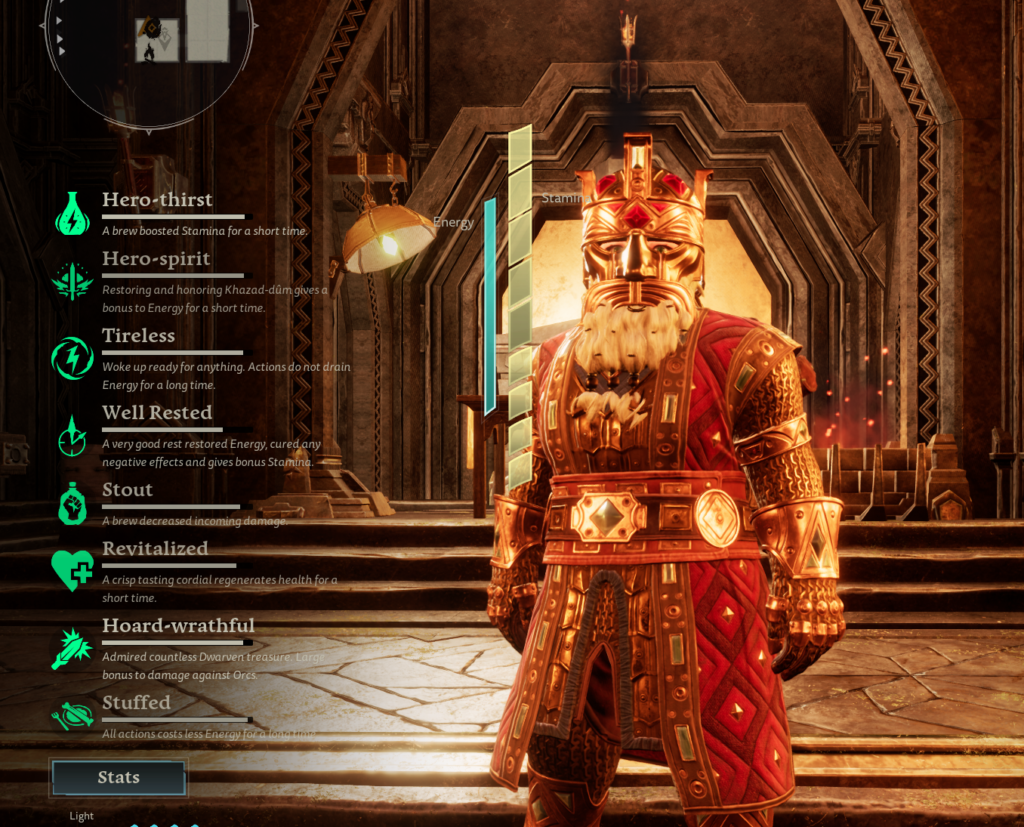
Death is fairly simple; the character wakes up in their bed and the player is forced to do a corpse run to retrieve their gear and everything they were carrying. When a character dies, their gear is usually broken as well, so a run back to base once the gravestone is retrieved is almost always necessary to repair everything.
The lower right of the UI features the Horde Sound Meter. This indicates what sounds impact it and how close the player is to an impending horde attack. Note this meter resets when the character sleeps. There are also Base Raids, which seems to be random. The other problem with base raids is if you simply go somewhere else (via a mapstone) the raid fizzles out and no damage is done to your base. As such it makes the mechanic fairly uninteresting and doesn’t require the player to truly protect their base.
They really need a difficulty setting for this game. It would allow for much more challenging playthroughs.
One of the biggest flaws with this game is the lack of a skill progression system. Much like V Rising, the character grows in power by building better gear. But the reality is players do not like this. Players want their characters skill to improve as they use weapons and interact with the world. And they should. Survival games with no skill growth are generally bad games. The omission of such a system is a deathknell to the overall survival concept of the game.
Believe it or not, Moria has Day and Night cycles. The main reason for this is ambience. Even though the player is deep within the depths, light often comes from far above through crystal domes or even breaks in the overhead fissures. It’s also part of the exploration heartbeat as both cold and darkness settle in much more intently during the night. Plants will also grow in areas where sunlight shines downward. As with other games, it’s best to sleep through the night until you’re very-well geared.
As such, Resting is very important. Characters grow Tired and Exhausted without proper rest. But the proper food and ale also has a major impact on how long a rested bonus lasts.

Economy
The Economy of Return to Moria really revolves around resources, crafting and repairing. While collaborative play with friends allows for sharing of resources, there’s no trading or any system in place to manage an economy other than resource gathering and refining. Even the acquisition of gold coins currently serves no real purpose other than building mounds of gold in a base to show it off. Since there’s no NPCs or stores, there’s really no true Economy. But, the economy is solid. Resources are abundant, obtaining them feels rewarding, and the sheer amount of craftable items and building pieces from all of the resources is fantastic.
Community
I admit to playing the game solo as I don’t know anyone on the Epic Games platform. However, I watched dozens of hours of streamers play, and most of them played with friends. It was quickly obvious how much fun this game is to play with other people.
There’s no game server list. Instead, Return to Moria uses a Hosted Code System where any player can host a game and share their code with friends. At this time there’s no dedicated servers, so a player hosting a game must be in and playing in order for others to be doing the same. The host controls the state of the storyline. Characters must also sleep at the same time and progress together on the same quest. While this is a fine design for launch, I hope the online nature of the game allows for players to join and adventure within a dedicated world with each Dwarf on their own quest. This approach would be a great experience as players could encounter each other in surprise as they venture through the depths. The only design issue that currently prevents the game from allowing dedicated servers are the mechanics of Tired, Exhausted and Starvation. Valheim doesn’t have these mechanics (nor a main quest storyline), so a player can go AFK and not worry about such things. With Return to Moria, the host can never leave the game, and that means they can never go AFK without either dying of starvation or getting stuck in Exhausted mode.
In order to support a dedicated world, Return to Moria has to make adjustments to the core of the game to allow for more of a Sandbox experience that’s managed by the world rather than a single or hosting player.

Technical
I didn’t encounter any Bugs on my playthrough, and that’s rather impressive. The Graphics are beautiful, the Music is excellent, and the voice acting top notch. The only annoyance I encountered related to the technical side of the game was how the Elven Quarter would take 10+ seconds to load each time when all other regions were 1-2 seconds.
Although some of the monster Sound FX are pretty cheesy (they use the same bear growl sound that every other game has over the past two decades), the auditory ambience of Moria is fantastic. There’s constant strange noises in the distance, and it truly sounds like the character is deep underneath the mountains.
The User Interface is very well designed and easy to navigate. It also has a unique feel to it that’s unlike any other game.
In the end, the game runs incredibly smooth for an initial release. Hats off to the developers for such a solid technical product!
End Game
The final boss fight is way too easy. The good news is the developers have already said they are going to fix the fight in an upcoming release.
The story ends when the final boss is killed and the character escapes the mines. After that, the game continues and the player can do whatever they want as the “Lord of Moria”. Mithril Armor (Tier VI) and Durin’s Lamp are unlocked, which removes the Shadow Curse. Sadly, there aren’t any new monsters or mechanics. The only real continued option of play is to clear and rebuild the mines. And many players are doing exactly that, but there isn’t any additional means of progression through the game. While it’s possible to reach end-game before unlocking everything, some players decide to hunt down the ranger scrolls or figurines they missed. Players can also start a new game with their existing decked out character including full inventory. The player can embark on a quest to purge all of the Shadow Curse spread throughout the region with an item that’s unlocked after finishing the storyline.
I wish the developers added a difficulty setting. This would have improved the replayability of the game greatly.
It’s very easy for players to think something should have been added and could have been so easy to add, but it’s important to not forget everything the core game has to offer. In that sense, Moria delivered. But there’s definitely room for future growth of the game. Perhaps some sort of “endless dungeon” exploration, or a new threat that required re-capturing key areas of Moria (or losing them to recapture), etc. I hope future expansions address this lack of end-game content because the core mechanics are there to do a lot and really make Return to Moria a true sandbox of nonstop action and fun.
Conclusion
Return to Moria is a great game. The first playthrough is absolutely epic, and the core mechanics and game design have amazing potential. While the learning curve can be a bit frustrating for new players and the replayability of the game is limited, overall it’s a solid experience and well worth the cost of admission. Players truly feel as if they are a Dwarf in the Mines of Moria, and presenting such an experience in a modern survival game is no easy feat. Yet Free Range Games did exactly that. I’m excited for the future of this game and hope they add a Dedicated Server option and evolve the world to support a true Sandbox experience.

